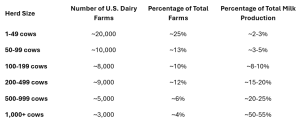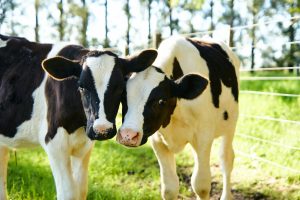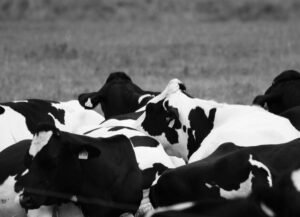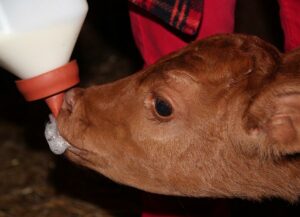Álvaro García
When I arrived in the Midwest in the 1980s to study, the U.S. dairy industry was undergoing significant transformation. While the shift toward consolidation and larger operations was already underway, smaller, family-owned farms still played a vital role in milk production. Understanding the structure and challenges of the industry during this era provides valuable context for the sustainability practices of today’s smaller dairies.
In the early 1980s, most dairy farms were small to mid-sized and family-operated. However, larger farms with five hundred or more cows were beginning to emerge, marking the start of a trend toward industrialization. The size distribution of farms at the time was distinct:
- Small farms (under one hundred cows): These were the backbone of the industry but faced mounting financial pressures.
- Medium-sized farms (100–500 cows): Common in the Midwest, these farms contributed a significant share of the nation’s milk.
- Large farms (500+ cows): Though still rare, these operations were early adopters of technological advancements and reaped the benefits of economies of scale.
Economic challenges of the era accelerated the decline of smaller dairies. Rising feed and labor costs, along with increasing land prices, made it difficult for small farms to remain competitive. Meanwhile, larger operations leveraged technological innovations and efficiency gains, leaving smaller farms struggling to keep up.
By the end of the decade, the number of U.S. dairy farms had plummeted from 140,000 in 1980 to about 100,000 in 1990. Many small diaries either closed or were absorbed into larger enterprises. This period also saw the dairy crisis of 1983–1985, when low milk prices caused financial distress for farmers, forcing many to sell their herds or consolidate.
A Shifting Industry
The 1980s marked the beginning of the consolidation that defines modern dairy farming. While the average herd size remained around 80–100 cows, the growth of larger operations set the stage for the industrialization that would dominate subsequent decades.
These challenges underscore the need for innovative practices to support smaller dairies. Adapting to economic and structural changes remains critical for their survival. Exploring approaches to improving profitability and sustainability can help these farms remain viable in an industry increasingly shaped by large-scale operations.
How can smaller dairies survive in the XXI century?
As of recent data from the USDA, 40% to 50% of U.S. dairy farms have fewer than 500 cows. These smaller dairies make up a smaller portion of the nation’s total milk production, with the majority coming from larger operations.

Dairies with fewer than 1,000 cows face unique challenges due to economies of scale working against them, but there are several strategies they can implement to remain profitable. Here are some key strategies for smaller dairies:
Focus on Efficiency and Cost Control
- Improve Feed Efficiency: Focus on optimizing feed rations and sourcing the best-quality feed at competitive prices. This can significantly reduce feed costs, which are one of the largest expenses for dairy operations.
- Optimize Herd Health and Reproduction: Improving herd health and reproduction rates can lead to more productive cows, fewer veterinary costs, and better milk yields.
- Utilize Technology: Use herd management software, milk monitoring systems, and automated feeders to streamline operations, track health and production metrics, and reduce labor costs.
- Energy Efficiency: Implement energy-saving measures, such as efficient milking systems, cooling systems, and renewable energy sources like solar panels, to reduce utility bills.
Diversification
- Value-Added Products: Consider adding value to the milk produced by diversifying into products like cheese, yogurt, butter, or organic milk. Direct-to-consumer sales (e.g., farmstead cheeses or raw milk) can significantly improve profit margins.
- Agri-tourism or Farm Stays: Hosting farm tours, events, or even offering farm stays can diversify income streams, particularly if the farm is in a region popular with tourists.
- Niche Markets: Specialize in organic, grass-fed, or non-GMO milk and dairy products. Many consumers are willing to pay a premium for these products.
Diversify Income Sources
- Off-Farm Revenue: Consider expanding into related agricultural activities like growing crops (corn, alfalfa) or offering services to other farms. For example, a small dairy could sell manure as fertilizer or offer custom planting or harvesting services.
- Contracting or Co-Op Membership: Some smaller dairies find it beneficial to join cooperatives or establish milk production contracts with processors, which may help secure more stable pricing and reduce market volatility.
Improve Marketing and Branding
- Direct-to-Consumer Sales: Selling directly to consumers (through farmers’ markets, farm stores, or online) helps retain more of the milk’s value, bypassing intermediaries.
- Storytelling and Branding: Consumers are increasingly interested in where their food comes from. Smaller dairies can leverage their “local” and “family-owned” aspects, telling their story through social media, websites, and in-person interactions to create strong customer loyalty.
- Local Partnerships: Collaborate with local businesses, such as cafes, restaurants, and retailers, to provide fresh, locally sourced dairy products. Establishing strong relationships with local chefs and food producers can provide a steady market.
Increase Sustainability and Resilience
- Sustainable Practices: Adopt sustainable farming practices, such as rotational grazing, low-carbon feed options, or waste-to-energy systems. This can reduce costs, improve the farm’s environmental footprint, and even make the farm eligible for grants or funding from sustainability programs.
- Climate Resilience: Invest in drought-resistant crops, efficient water management systems, and resilient pasture management to handle fluctuations in weather patterns and reduce risks related to climate change.
Leverage Government Programs and Grants
- Farm Support Programs: Take advantage of government subsidies, grants, and loans available for small and medium-sized farms, including those that encourage sustainability and innovation. The USDA offers various assistance programs that can help with the costs of transitioning to organic production, improving farm infrastructure, or addressing challenges related to climate change.
- Crop Insurance: Purchase crop insurance or milk price insurance to protect against unexpected income fluctuations from market changes or weather events.
Collaborate and Join Cooperatives
- Cooperative Membership: Many small dairies benefit from joining cooperatives, which help them pool resources to negotiate better milk prices, reduce operational costs, and access marketing and processing services that would otherwise be unavailable.
- Shared Equipment: Small dairies can also share equipment like tractors, silos, or milking systems with neighboring farms to reduce capital expenditures.
Focus on Customer Relationships and Loyalty
- Customer Education: Educate consumers on the benefits of buying from local and small-scale dairies. Transparency in farming practices, animal welfare, and product quality can create a strong consumer base.
- Subscription Models: Offer subscription services for dairy products, especially for niche or value-added items. Subscription models help create steady cash flow and customer loyalty.
Increase Productivity with Genetic Improvement
- Selective Breeding: Focus on improving the genetics of the herd to increase milk yield, improve health and fertility, and reduce the cost of replacement animals. In some cases, crossbreeding with more efficient breeds can improve herd productivity, especially in terms of feed conversion and disease resistance.
Labor Efficiency
- Labor: Smaller dairies often operate with fewer employees, so making sure each worker is as efficient as possible is crucial. Automation (where feasible) or investing in labor-saving equipment can ease workload and reduce reliance on seasonal or temporary workers. Many smaller dairies are family-run operations. Using family members for labor can reduce labor costs, but it is important to ensure a balance between work and personal life to prevent burnout.
By combining several of these strategies, dairies with fewer than 1,000 cows can remain competitive, stay profitable, and continue to do well despite the challenges posed by larger, more industrialized operations.
© 2025 Dellait Knowledge Center. All Rights Reserved.









